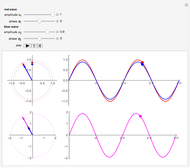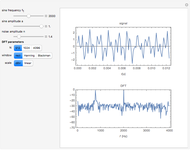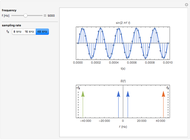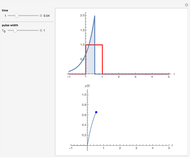Discrete Fourier Transform of a Two-Tone Signal

Requires a Wolfram Notebook System
Interact on desktop, mobile and cloud with the free Wolfram Player or other Wolfram Language products.
A two-tone signal is the sum of two sine waves plus a noise signal. One sine wave has the frequency 770 Hz and the amplitude 1. The frequency and the amplitude of the second sine wave as well as the noise amplitude are controlled by the sliders.
[more]
Contributed by: Carsten Roppel (March 2011)
Open content licensed under CC BY-NC-SA
Snapshots
Details
The discrete-time two-tone signal is
 ,
,
where  ,
,  , and
, and  is generated from a uniform distribution in the range
is generated from a uniform distribution in the range  to
to  . You control the parameters
. You control the parameters  ,
,  , and
, and  with the sliders. The
with the sliders. The  -point DFT of the signal is
-point DFT of the signal is
 .
.
The spectrum plot shows  . The factor
. The factor  results in a spectral line of height 1 for a sine wave of amplitude 1 if the sampling interval
results in a spectral line of height 1 for a sine wave of amplitude 1 if the sampling interval  is an integer multiple of the sine frequency.
is an integer multiple of the sine frequency.
If a window function  is applied, the signal is multiplied by
is applied, the signal is multiplied by  before the DFT is calculated. The Hanning window is
before the DFT is calculated. The Hanning window is
 ,
,
and the Blackman window is
 .
.
Permanent Citation












